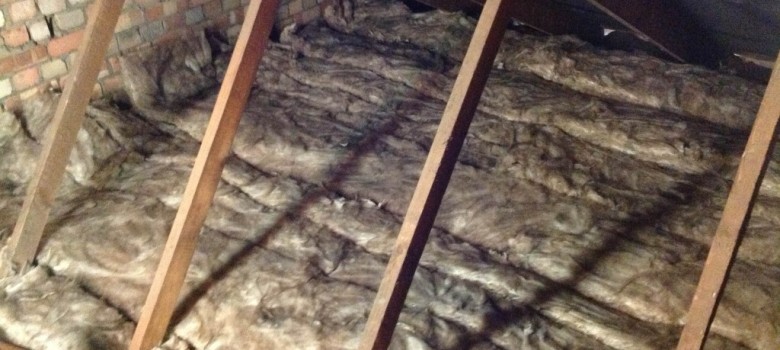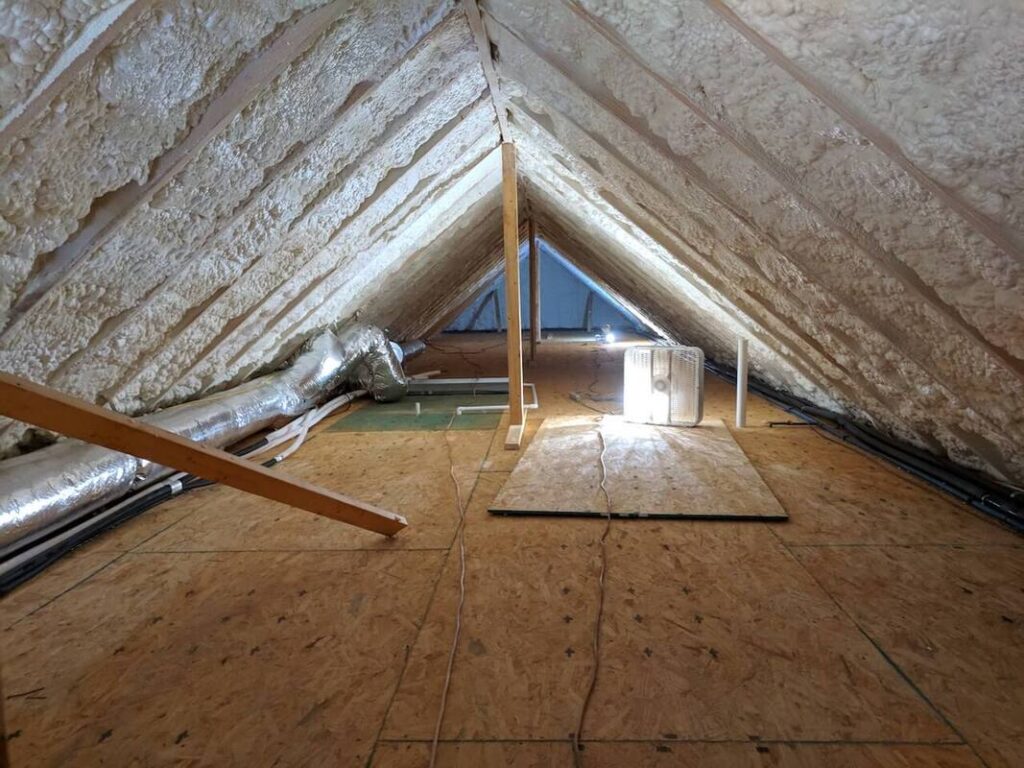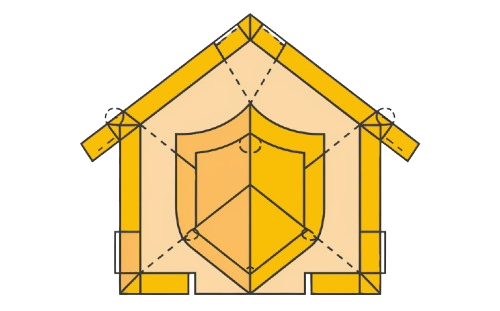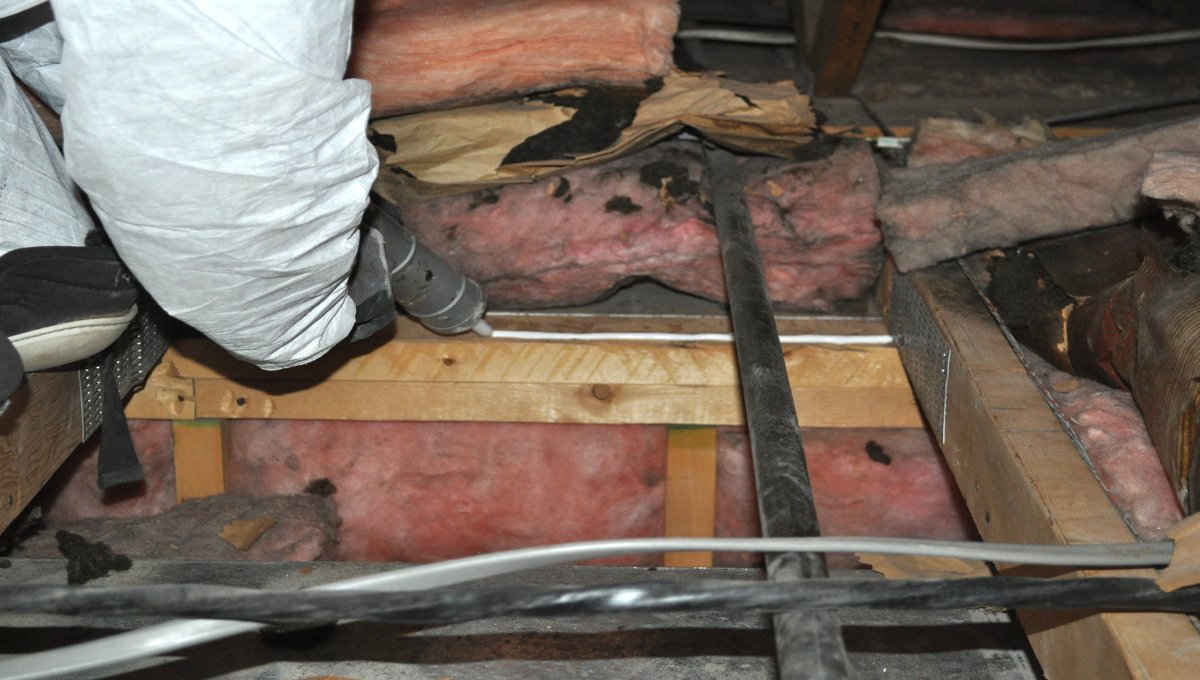If you’ve ever considered upgrading your attic with spray foam insulation, you’ve likely questioned whether the existing insulation should be removed. Many homeowners think about keeping the old materials, like fiberglass, cellulose, or batts, to save on investments they’ve already made. But the truth is, what worked in the past may not be the best choice for the future.

Traditional insulation methods often fall short when it comes to providing the comfort and protection modern homes need. Spray foam is a new approach that can deliver more effective results. However, starting with a clear space is important to ensure the foam can meet your expectations. Keeping old insulation in place might seem easier, but it can cause issues with airflow, efficiency, and overall performance. Removing it first will make sure you get the desired outcome without any shortcuts.
Does Attic Insulation Need To Be Removed Before Adding Spray Foam?
Yes, old attic insulation needs to be removed before applying spray foam. Keeping outdated materials can hinder airflow, cause moisture problems, and reduce efficiency. Clearing out the attic floor is essential to ensure the foam fully insulates and provides a lasting solution for your home.
Keeping old insulation in place might seem easier, but it reduces the foam’s ability to fully insulate and creates problems in maintaining a consistent temperature. By removing outdated insulation and clearing out the attic floor, you’re providing the foam with the right surface to stick to. This step is essential to ensure the foam works efficiently, preventing temperature fluctuations and solving airflow issues. It’s not just about adding new materials; it’s about doing the job properly to create a long-term solution for your home.
What Insulations Are Commonly Found in Attics?
Most homeowners have fiberglass or blown insulation in their attics, as these are popular choices due to their relatively low cost and ease of installation. Batts and blown insulation are commonly found types, but they often fail to provide the energy savings that many had hoped for. Over the years, these insulations can pile up or get combined, reducing their effectiveness. If you need to replace attic insulation, it’s important to understand that these older options might no longer meet the needs of a modern home. Homeowners looking for better insulation solutions should consider what materials will best provide long-term benefits without needing frequent replacement.
Why Spray Foam Insulation Performs Better Than Traditional Options
When it comes to insulation, spray foam stands out because it offers superior performance compared to traditional insulations. Unlike older methods that may allow air and heat to move through gaps, spray foam creates an airtight seal, which prevents hot air from entering your attic in the summer and keeps your home cooler. This resistant barrier works by sealing surfaces and stopping heat transfer, both through direct contact and convection, making your home more energy-efficient.

Additionally, spray foam insulation delivers long-term results by lowering your energy bills and reducing the risk of moisture issues. Its reliable sealing capabilities are especially important for attics, where temperatures can become insufferably hot if the space is not properly insulated. The product’s proven performance comes from its ability to fill gaps and stop airflow at depths that other materials can’t match. If you’re looking for an effective solution that lasts for years, spray foam insulation is the better choice.
Also Read: Spray Foam vs Blown-In Insulation
Why Existing Insulation Must Be Removed Before Installing Spray Foam
Removing Old Insulation Helps Improve Air Circulation in Your Home
Removing old insulation from the attic is not just about making space for spray foam. It’s about creating a better air circulation system in your home. Existing insulation, especially fiberglass or cellulose, can become a major hindrance to airflow if left in place. These materials fall apart, pile up, and block the natural movement of air, which is essential for maintaining a conditioned and cooler attic. Blown-in insulation, in particular, tends to loosen over time, allowing air drafts to pass through and making it harder for your home to stay at a consistent temperature.
When spray foam insulation is applied directly on top of old materials, it cannot adhere properly. The foam needs a clean surface to bond tightly, creating an airtight seal that prevents heat and moisture from entering your house. If this adhesion doesn’t happen, you’ll experience energy loss, higher bills, and drafts that reduce the performance of your insulation. By removing old insulation, you ensure that the foam can fill gaps, lower heat exchange, and keep your home properly insulated for years to come.
Additionally, keeping old batt or cellulose insulation can trap dust, garbage, and even moisture, creating problems like mold and devastating damage to the roof deck or walls. The best approach is to remove it fully and start fresh. This way, you avoid waste, get an airtight barrier, and enjoy a more efficient living space without worrying about unfortunate issues caused by leaving outdated materials behind.
Why Attic Circulation Matters for Better Insulation
Proper circulation in your attic is crucial because it keeps the airflow moving freely throughout your home. If the air inside the attic doesn’t flow efficiently, it hinders your appliances like the furnace and AC unit, making them work harder to maintain the temperature. This not only wears down your appliances but also increases your bills over time.
When you insulate the attic deck or floor with spray foam, it’s important to ensure vents and ventilation are in place to prevent hot air from getting trapped. Without proper airflow, hot spots can develop, making the house feel unevenly heated. By removing old insulation and allowing cooler air to circulate, you can create a more comfortable environment inside the house while reducing the strain on mechanical systems.
Removing Old Attic Insulation Prevents Uneven Temperatures
Keeping old insulation in the attic can cause temperature differences that make your home uncomfortable. For example, if it’s 85 degrees outside, the attic may reach up to 100 degrees, while the rest of the house stays around 70 degrees. This happens because the airflow inside the attic is often hindered by older materials like fiberglass or cellulose that no longer work efficiently. This big temperature difference can lead to moisture issues, causing condensation and even mold growth, making it harder to keep the home comfortable.
To avoid this, it’s vital to remove old insulation and ensure that the air circulates evenly throughout the attic and living space. When air circulation is blocked, certain areas of the attic can feel blazing hot, especially during the summer, while other parts remain cooler. This imbalance puts extra strain on your HVAC system, making it work harder to keep the house at a steady temperature. By removing outdated materials, you reduce the risk of humidity problems, ensure consistent airflow, and make your home more comfortable year-round.
Removing Old Insulation Helps Prevent Unwanted Smells
One of the main reasons to remove old insulation is to avoid unwanted smells that can get trapped in your attic. Old insulation, especially if it’s been there for years, can be infested with rodent droppings, bugs, or even mice, creating unpleasant odors that are hard to get rid of. Additionally, during the process of spraying foam, amines — chemical compounds released by the foam — can make the attic smell like a litter box. If the old materials absorb these smells, it becomes even more difficult to remove them later. That’s why it’s best to remove the existing insulation before starting any spray foam installation.
Another problem with keeping old insulation is that it can cause odors to spread through the home, especially if the attic is vented. Odors that once escaped through vents will now be sealed in, making the house smell worse over time. Even some contractors fail to ventilate properly during the spray foam process, which makes the problem worse. To avoid these issues, it’s important to allow proper ventilation and removal of old materials before installing new insulation. This ensures that your attic stays clean, airtight, and free from unwanted smells.
Adding Spray Foam to the Existing Attic Floor
In some cases, people consider adding spray foam insulation directly to the attic floor instead of the roof deck. While this might seem beneficial, it can create issues if done incorrectly. When you insulate the floor, you’re essentially cutting it off from the rest of the house, which reduces air circulation and might require the attic to be vented. The purpose of vents is to bring cooler air from outside into the space to maintain a constant temperature inside the attic. Without proper airflow, you risk moisture buildup and temperature differences that could lead to condensation problems on the drywall.
Another important consideration is the thickness of the foam. If the foam isn’t applied correctly and the old insulation isn’t removed, you won’t get an airtight seal, which means the insulation won’t work efficiently. The difference between insulating the roof deck and the floor is that one creates an effective barrier, while the other can trap warm air and cause issues with condensation. For the best results, it’s better to focus on insulating the roof deck and ensuring all vents are working to help maintain the right air circulation throughout the attic.
Final Thoughts on Removing Old Insulation Before Applying Spray Foam
Removing old insulation before applying spray foam is the best way to ensure your home stays comfortable and properly insulated. By eliminating old materials, you can create better airflow, prevent mold growth, and tackle temperature issues throughout the house. If you want to enjoy a long-term solution, it’s important to get professional expertise to insulate your attic the right way. SPF roofing can make your home more efficient, but it must be installed properly to avoid future problems.
Contact us today to connect with experienced professionals who can help ensure your insulation is done properly. This will ensure your home stays energy-efficient and comfortable for years to come!

